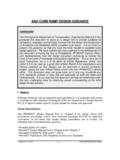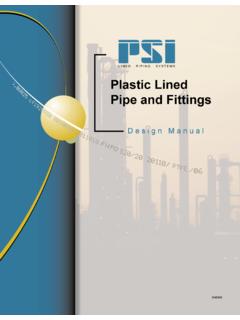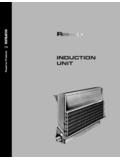Transcription of THERMAL METAL SPRAY: SUCCESSES, FAILURES …
1 Corrosion & Prevention 2012 Paper 167 - Page 1 THERMAL METAL spray : successes , FAILURES AND LESSONS learned Willie L Mandeno Opus International Consultants Ltd, Wellington, New Zealand SUMMARY: Thermally sprayed METAL (TSM) includes proven long term protective coating systems for steelwork in a marine environment such as THERMAL sprayed zinc (TSZ) and THERMAL sprayed aluminium (TSA); however specifiers have been slow to adopt these in Australia. This paper reviews the technology then looks at several projects in New Zealand and overseas, some where a premature failure has occurred, and discusses these and the lessons that should be learned .
2 It concludes with recommendations as to how coating specifications could be improved so that TSM s potential long life performance can be achieved. Keywords: THERMAL METAL spray , Protective coating, TSZ, TSA, Specification 1. INTRODUCTION The process of spraying molten METAL onto steel was first patented in Switzerland by Dr Schoop and introduced to the UK in 1912, but did not become a commercial reality until the early 1920's [1]. METAL spraying of bridge components ( the Menai Straits Bridge) was carried out in Britain before World War II. Because of the significant reduction in maintenance, flame sprayed zinc supplemented by paint became widely specified by British engineers for many major structures around the world, including the Auckland Harbour Bridge (1958), the Forth Road Bridge (1964), and the Pierre-Laport suspension bridge across the St Lawrence at Quebec (where from 1978-84 some 165,000 sqm was coated after failure of the original paint system) [2].
3 Use of flame sprayed zinc as a primer declined with the introduction of the self-curing types of inorganic zinc silicates in the 1970's and has since mainly been used to coat steel components that could not be galvanized , ie by dipping into a bath of molten zinc. Typical production deposition or melt rates of zinc wire when flame spraying were 10-20 kg/hr. The arrival of arc spray technology in the mid 1960's greatly increased coating adhesion and gave typical application rates of 10-35 kg/hr using a mm maximum sized wire, but the finish of the sprayed METAL was rougher and spray efficiencies of 50% were typical. In 1990 high deposition low energy systems became available which were also much lighter and portable.
4 These give deposition rates of 20-90 kg/hr with deposition efficiencies of over 70% when arc spraying mm wire. However there was an inherent problem of arc shorting when spraying large diameter wire at low amperages (250-400 A) which was overcome by a patented control system that can adjust the arc gap while spraying in less than of a second [3]. This and other recent developments in atomisation control giving smoother finishes have reduced application costs and have made THERMAL METAL spray a very competitive long life coating system. A description of the main processes involved in THERMAL spray , and a discussion of the advantages and disadvantages of TSM as a protective coating for steel when compared to galvanizing or coating with inorganic zinc silicate, have been given in an earlier paper by the author [4].
5 2. EXPOSURE TRIALS In North America the TSM process is known as metallizing with early work being carried out by the American Welding Society who in 1953 exposed panels coated with flame sprayed zinc and aluminium and various sealers. Very favourable results were reported after 19, 34 and 44 years of exposure at coastal and industrial sites [5,6,7]. This work was followed Corrosion & Prevention 2012 Paper 167 - Page 2 up by the US Corps of Engineers with successful trials of TSM as a more abrasion resistant coating than vinyl on dam gates, and which resulted in a comprehensive design manual [8] which is available on the internet. The US Federal Highway Agency (FHWA) noted [9] that work by the AWS and US Navy showed that properly applied metallized coatings (zinc, 85% Zinc/15% Aluminum, and Aluminum) of at least 6 mils thickness provide at least 20 years of maintenance free corrosion protection in wet, salt-rich environments and are expected to provide 30 years of protection in most bridge exposure environments.
6 The FHWA has sponsored several research projects coating steel bridge beams with TSM, including one of environmentally acceptable materials which found that the TSZ systems were the best performing over 40 coating systems tested (which included uncoated and topcoated high -ratio and other IOZ s) with no undercutting at scribe marks after years exposure, and had the lowest Life Cycle Cost [10]. THERMAL Sprayed Aluminium (TSA) has been widely used in offshore oil and gas industry and by 1997 over 400,000 sq metres of TSA had been applied to oil platforms in the North Sea [11] to provide corrosion protection to flare stacks, riser pipes in the splash zone and submerged tethered legs ( Conoco s Hutton platform built in 1984).
7 Experience indicated that TSA coatings, when properly applied and with the use of specific sealer systems, will provide a service life in excess of 30 years with zero maintenance required [12]. 3. STANDARDS The two main standards available for local specifiers are the International Standard ISO 2063 [13] (with its various national equivalent versions such as BS EN ISO 2063) and the North America joint Standard, NACE 12/AWS [14]. These are supported by other standards that cover guidance in such matters as specification [15], operator qualification [16], and adhesion testing [17]. In addition, individual groups such as oil companies and military organisations have their own in-house specifications [18,19].
8 Expected durability of TSM systems in different atmospheric environments have been given in recent versions of AS/NZ 2312 which were initially derived from international sources such as BS 5493 [20], ISO 14713 [21] and ANSI/AWS [15]. These expected lives to first major maintenance (when breakdown exceeds 2% rust) are given in the Tables below. The suffix S denotes a sealed coating with the TSM thickness given in microns. Note that these tables are likely to be further amended as part of the current revision of AS/NZS 2312. Table 1: AS/NZS 2312:1994 [22] Atmospheric Classification Years to first major maintenance >2 to 5 >5 to 10 >10 to 20 >20 to 25 >25 to 40 >40 Moderate - - ZN100 ZN150 ZN175 ZN300 Marine - ZN100 ZN75S ZN150 ZN100S ZN150S AL150 ZN350 AL275 ZN375S AL275S Severe Marine ZN100 ZN150 ZN250 AL275 AL325 Table 2: AS/NZS 2312.
9 2004 [23] System designation Super-seded design-nation Nominal coating thickness um Durability Years to first maintenance Atmospheric corrosivity category A Very low B Low C Medium D High E-I Very high indust-rial E-M Very high marine F Inland Tropical TSZ100 ZN100 100 25+ 25+ 25+ 15-25 NR 5-15 25+ TZS150 ZN150 150 * * 25+ 25+ NR 10-25 25+ TSZ200A ZN200S 200+seal * * 25+ NR 25+ * TSA150S AL150S 150+seal * * 25+ 25+ 15-25 15-25 25+ TSA225S AL225S 225+seal * * * 25+ 25+ 25+ 25+ NR = Not recommended * Very high durability but unlikely to be economic Corrosion & Prevention 2012 Paper 167 - Page 3 4. SEALING AND PAINTING OF TSM THERMAL sprayed METAL , and zinc in particular, can have their performance in marine environments enhanced by sealing the pores and surface with a low viscosity material with good wetting properties such as vinyl, acrylic, or thinned epoxy or urethane.
10 Silicone aluminium is used for high temperature applications. This is applied soon after spraying the METAL and until absorption of the sealer is complete. Use of aluminium or coloured pigments can give a more uniform appearance of the coating, while the binder decreases exposure of the METAL to the environment. High build paint coatings are unnecessary and as for galvanizing can reduce the system life by trapping salts and moisture against the METAL at coating defects [24]. The increased life due to sealing is shown in the table above, where sealing zinc is approximately equivalent to adding a third more METAL thickness.





